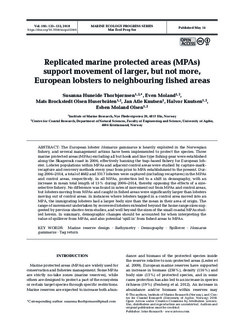| dc.contributor.author | Thorbjørnsen, Susanna Huneide | |
| dc.contributor.author | Moland, Even | |
| dc.contributor.author | Huserbråten, Mats Brockstedt Olsen | |
| dc.contributor.author | Knutsen, Jan Atle | |
| dc.contributor.author | Knutsen, Halvor | |
| dc.contributor.author | Olsen, Esben Moland | |
| dc.date.accessioned | 2018-09-10T09:17:12Z | |
| dc.date.available | 2018-09-10T09:17:12Z | |
| dc.date.created | 2018-07-04T11:02:21Z | |
| dc.date.issued | 2018 | |
| dc.identifier.citation | Marine Ecology Progress Series. 2018, 595 123-133. | nb_NO |
| dc.identifier.issn | 0171-8630 | |
| dc.identifier.uri | http://hdl.handle.net/11250/2561678 | |
| dc.description.abstract | The European lobster Homarus gammarus is heavily exploited in the Norwegian fishery, and several management actions have been implemented to protect the species. Three marine protected areas (MPAs) excluding all but hook and line type fishing gear were established along the Skagerrak coast in 2006, effectively banning the trap-based fishery for European lobster. Lobster populations within MPAs and adjacent control areas were studied by capture-mark-recapture and recovery methods every year from prior to MPA establishment to the present. During 2006-2014, a total of 4682 and 3317 lobsters were captured (including recaptures) in the MPAs and control areas, respectively. In all MPAs, protection led to a shift in demography, with an increase in mean total length of 15% during 2006-2014, thereby opposing the effects of a size-selective fishery. No difference was found in rates of movement out from MPAs and control areas, but lobsters moving from MPAs and caught in fished areas were significantly larger than lobsters moving out of control areas. In instances where lobsters tagged in a control area moved into an MPA, the immigrating lobsters had a larger body size than the mean in their area of origin. The range of movement undertaken by recovered lobsters extended beyond the home range sizes suggested by previous shorter-term studies, and well beyond the sizes of the small coastal MPAs studied herein. In summary, demographic changes should be accounted for when interpreting the value of spillover from MPAs, and also potential ‘spill in’ from fished areas to MPAs. | nb_NO |
| dc.language.iso | eng | nb_NO |
| dc.title | Replicated marine protected areas (MPAs) support movement of larger, but not more, European lobsters to neighbouring fished areas | nb_NO |
| dc.title.alternative | Replicated marine protected areas (MPAs) support movement of larger, but not more, European lobsters to neighbouring fished areas | nb_NO |
| dc.type | Journal article | nb_NO |
| dc.type | Peer reviewed | nb_NO |
| dc.description.version | publishedVersion | nb_NO |
| dc.source.pagenumber | 123-133 | nb_NO |
| dc.source.volume | 595 | nb_NO |
| dc.source.journal | Marine Ecology Progress Series | nb_NO |
| dc.identifier.doi | 10.3354/meps12546 | |
| dc.identifier.cristin | 1595576 | |
| cristin.unitcode | 7431,23,0,0 | |
| cristin.unitcode | 7431,20,0,0 | |
| cristin.unitcode | 7431,12,0,0 | |
| cristin.unitname | Populasjonsgenetikk | |
| cristin.unitname | Oseanografi og klima | |
| cristin.unitname | Bentiske ressurser og prosesser | |
| cristin.ispublished | true | |
| cristin.fulltext | original | |
| cristin.qualitycode | 2 | |
